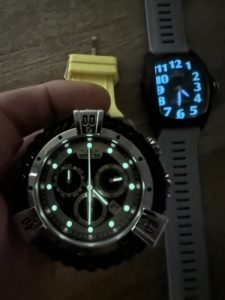
One of the most satisfying feelings I have as an horologist is when I turn off my closet light after it’s been on for a while and I see my watches that have glow-in-the-dark features. Although I love looking at them glowing, not all my watches have the same effect. This ability to glow, usually referred to as luminosity, can vary from watch to watch. But luminosity in watches… What is it and why should you care? Let’s take a little time (pun intended) to break it down.
Jack Forster, Editor In-Chief of Hodinkee, describes the luminosity of watches as follows:
While the exact quantum mechanical description of photoluminescence is complicated, the basic idea is simple: if an electron orbiting an atom in a certain material absorbs a photon, it will be excited to a higher energy state, and when the electron “relaxes” to its ground state, it emits a photon which we see as visible light. (Forster, 2018)

Luminosity describes when various parts of a watch dial “glow in the dark.” Often the hour/minute/second hand are illuminated, as well as some markers on the dial to give the wearer a frame of reference (12 o’clock, for example). While luminosity has been present in watches for most of the twentieth century, technology has advanced significantly in the last 30 years. The main problems scientists and watch designers must tackle with luminosity are degree of lighting, a power source, decay, and radiation or adverse effects.
Luminosity began in 1908 with radium paint, a highly radioactive material that led to radiation-related health problems for many watchmakers/ who worked with it. Based on the same, the watch industry began looking for other alternatives. The appeal of the radium, though, was the ability for the watch to shine even when it was not exposed to light. Watch creators found alternative forms of luminosity in two different forms. The first used safer radioactive materials to produce light even without exposure to a light source. Promethium was the first such material, a much safer alternative to radium but one that dims and decays extensively. Tritium, a gas that glows stronger and longer, came next.
The second alternative form of luminosity consisted of materials that store up energy from the sun and reflect it back to the watch wearer. LumiNova and Super-LumiNova are the two forms of this energy storage. While it boasts very bright luminosity, it still requires to be “charged” by an outside light form.

“Ok, now I understand luminosity. Why should I care?” you may be asking? I’m glad you asked. The degree of luminosity is an important factor to many watch consumers. For those who work at night – say, police officers or soldiers – being able to check the time at a glance is very important. Or if you’re simply someone who loves adventure or forgets to take their watch off at night, seeing the time in the dark is a major benefit.
The only problem is… Jewelry stores have crazy good lighting. You may need to check reviews, online photographs, or find a buddy who has one to get a feel for the luminosity’s reliability. Sometimes paying close attention to the markings on the dial and on the hands of the watch can be telling as to the degree of luminosity but that is not always a safe bet. Your best option would be to buy a watch built for viewing in the dark or one that’s highly rated for the same. Looking for a specific recommendation? The 3 watches pictured in this article have pretty phenomenal luminosity – my Invicta Lupah 0434, Invicta Sea Hunter 10719, and Invicta Hercules 35579.
Resource:
Forster, J. 2018. https://www.hodinkee.com/articles/luminous-dials-what-makes-them-glow-and-how-to-spot-their-differences
6.